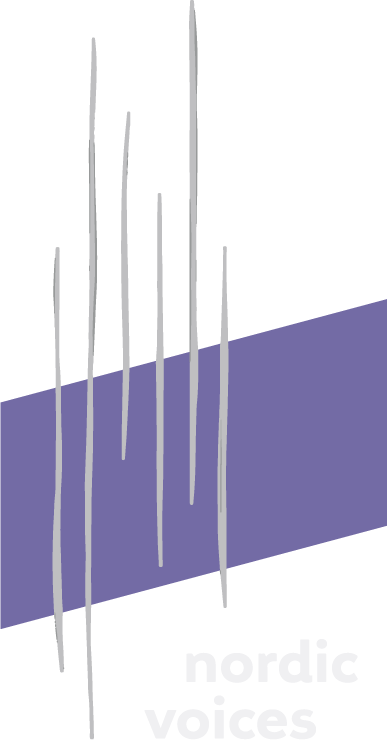Advent Calender
Hello world, join us for the most optimistic Christmas ever! We will share a song every day until the 24th of December in our Advent Calender. Please listen:
On the third of December, we will share a recording of Pierre de Manchicourt. He was born in 1510 in France. Nordic Voices enjoys singing the best and sadest music of the last 500 years. Few records of Manchicourt’s life survive: information about his life and work is obtained primarily from publications of his works. The earliest known information indicates that in 1525 he was a choirboy at Arras. By 1539, he was provost at the cathedral in Tours, where he would have had access to a considerable library of the works of the great master, and previous incumbent, Johannes Ockeghem. For at least nine years, from 1545 to 1554, he held the post of maître de Chapelle at Nôtre-Dame Cathedral in Tournai. On the death of the incumbent, Nicolas Payen, in 1559, Manchicourt was appointed maestro de Capilla Flamenca (master of the Flemish chapel) at the court of Philip II in Madrid, which post he held until his death five years later. The fact that Pierre Attaingnant, publisher of the French Royal Court, devoted his fourteenth and final volume of motets in 1539 entirely to Manchicourt’s work (an honour he bestowed on no other and emulated by Flemish publishers Susato and Phalèse in 1545 and 1554 respectively) bears testament to the composer’s reputation in his day. Around the time of his death, Manchicourt’s highly polyphonic style of composition rapidly went out of fashion — a fate shared with his contemporaries Nicolas Gombert, Jacobus Clemens and Thomas Crecquillon — as the liturgical reforms of the Council of Trent took hold, marking the transition from the High Renaissance to the less florid Late-Renaissance style of Victoria and Palestrina. The kings of the earth are gathered, they have come together as one, saying: Let us go to Judea and ask: “Where is he that is born a great king, whose star we have seen?” Alleluia. And when they came, they found the young child with Mary, his mother, and, falling down, they worshipped him, offering him gold, incense and myrrh. Alleluia.
English translation
The kings of the earth are gathered,
they have come together as one, saying:
Let us go to Judea and ask:
“Where is he that is born a great king,
whose star we have seen?” Alleluia.
And when they came, they found the young child
with Mary, his mother,
and, falling down, they worshipped him,
offering him gold, incense and myrrh. Alleluia.
Fjerde desember er en dag for Gisle Kverndokk. Det er på tide med en ny lytting av Gisle Kverndokks Tidens Fuge. Gisle Kverndokk er nært tilknyttet Nordic Voices med flere store bestillinger. Fuge der Zeit har en tittel påvirket av poeten Paul Celan (1920-1970), fra hans dikt «Auge der Zeit» Når Kverndokk tar i bruk fire dikt av Celan som han sidestiller med «Forkynneren» der det jo heter «Alt har sin tid» er det åpnebart at Gisle forsøker å stanse tiden, og heller skape et rom å lytte i. Tiden blir til rom: LYTT!
Nordic Voices are still singing. All our concerts are cancelled, but now when we celebrate the 6th of December in our Advent Calendar, we want to share the music of Maja S. K. Ratkje with this video of Audun Notevarp Sandvold. Please spend some minutes, and hear it all through. Everything is going to be alright! We love to meet you soon at concerts. SOUND ON!
Etter flere års arbeid er innspillingen av “Beatitudes” av Henrik Ødegaard med Nordic Voices og Oslo kammerkor klar for lansering nå i 2020. Verket ble bestilt av Oslo internasjonale kirkemusikkfestival. Grappa musikkfortlag slipper utgivelsen midt i oktober. Produsent er Jørn Pedersen og dirigent er Håkon Daniel Nystedt.
Beati estis qui maledixerint vobis
Nordic Voices sings Bysjan Bysjan Båne, a traditional folksong, in Frank Havrøy’s excellent arrangement for the six a cappella vocalists. A lullaby that works!
Today, the 13. of December we share Karheinz Stockhausen Stimmung. It is also introduced by his daughter Christel Stockhausen Hektoen who lives in Oslo. Stockhausen himself attributes a month spent walking among ruins in Mexico as his primary influence too Stimmung, Stimmung recreating that ‘magic’ space. On the other hand, he also describes the snow on frozen Long Island Sound in February and March 1968 (when he was composing Stimmung in Madison, Connecticut), as “the only landscape I really saw during the composition of the piece” (Cott 1973, 163). In a letter to Gregory Rose written on 24 July 1982 (printed in the liner notes to Hyperion CDA66115), he describes how in the small house his wife Mary had rented it was only possible for him to work at night because their two small children needed quiet during the day. He could not sing aloud, as he had done initially, but began to hum quietly, listening to the overtone melodies. Mary reports that Stockhausen first discovered the technique when listening to their small son Simon producing multiple tones while humming in his crib after falling asleep. In this way, Stockhausen became “the first Western composer to use this technique of singing again—in the Middle Ages it had been practiced by women and children in churches, but was later entirely supplanted by masculine Gregorian music”
We are getting closer to Christmas, it´s the 15th of December. Listen to
On the 17th of December, we share one of our newest releases with the music of the composer Henrik Ødegaard. O vos omnes
This text (from Lamentations 1:12) exists in a shorter form, as an antiphon, and a longer form, as a responsory (the fifth of the nine responsories for Matins of Holy Saturday).
A responsory is a sung response to a Scripture reading. It has two parts: a respond and a versicle. After the versicle (indicated below by V. and usually sung by a single voice or a smaller group), the second part of the respond (indicated below by a bullet) is repeated.
O vos ómnes qui transítis per víam, atténdite et vidéte:
Si est dólor símilis sícut dólor méus.
V. Atténdite, univérsi pópuli, et vidéte dolórem méum.
Si est dólor símilis sícut dólor méus.
Translation
O all you who walk by on the road, pay attention and see:
if there be any sorrow like my sorrow.
V. Pay attention, all people, and look at my sorrow:
if there be any sorrow like my sorrow.
Etter flere års arbeid er innspillingen av “Beatitudes” av Henrik Ødegaard med Nordic Voices og Oslo kammerkor klar for lansering nå i 2020. Verket ble bestilt av Oslo internasjonale kirkemusikkfestival. Grappa musikkfortlag slipper utgivelsen midt i oktober. Produsent er Jørn Pedersen og dirigent er Håkon Daniel Nystedt.
Still in Silence and in this version we sing together with
21. desember, solsnudagen synger vi Solbøn av Lasse Thoresen. Dette stykket er basert på en enkel sang, nærmest en vuggesang. Denne har Lasse Thoresen notert, med alle små mikrotonale og ornamentale nyanser, etter Berit Opheim, som igjen har sangen fra Agnes Buen Garnås. “Tru soli måtte skine, yvi småbådni mine. Yvi topp, yvi tre, yvi folk, yvi fe, yvi åker og eng, yvi hus og hjem, og yvi Jomfu Marias silkeseng.” Dette er er teksten som ga komponisten ideen til å la en sangmelodi med bare fem tonehøyder og en varighet på 25 sekunder bli utkomponert til over et ti minutter langt verk. Teksten er en bønn om lyd, om at lyd og varme skal omhylle alle kjære ting. Tidsstrekket i verket er åpnngsprosessen henimot lyset, men nå i en klanglig forstand. Og det indre lys – det bryter frem innenfra sangtonene selv: når overtonene som bor i hver enkelt sangers tone får komme frem i dagen, en etter en, og i strålebunter.

